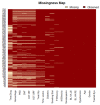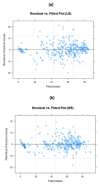Application of Machine Learning to Ranking Predictors of Anti-VEGF Response
- PMID: 36431061
- PMCID: PMC9699567
- DOI: 10.3390/life12111926
Application of Machine Learning to Ranking Predictors of Anti-VEGF Response
Abstract
Age-related macular degeneration (AMD) is a heterogeneous disease affecting the macula of individuals and is a cause of irreversible vision loss. Patients with neovascular AMD (nAMD) are candidates for the anti-vascular endothelial growth factor (anti-VEGF) treatment, designed to regress the growth of abnormal blood vessels in the eye. Some patients fail to maintain vision despite treatment. This study aimed to develop a prediction model based on features weighted in order of importance with respect to their impact on visual acuity (VA). Evaluations included an assessment of clinical, lifestyle, and demographic factors from patients that were treated over a period of two years. The methods included mixed-effects and relative importance modelling, and models were tested against model selection criteria, diagnostic and assumption checks, and forecasting errors. The most important predictors of an anti-VEGF response were the baseline VA of the treated eye, the time (in weeks), treatment quantity, and the treated eye. The model also ranked the impact of other variables, such as intra-retinal fluid, haemorrhage, pigment epithelium detachment, treatment drug, baseline VA of the untreated eye, and various lifestyle and demographic factors. The results identified variables that could be targeted for further investigation in support of personalised treatments based on patient data.
Keywords: age-related macular degeneration; anti-VEGF treatment; explainability; statistical modelling.
Conflict of interest statement
The authors declare no conflict of interest.
Figures












References
-
- Donders F.C. Beiträge zur pathologischen Anatomie des Auges [Contributions to the pathologic anatomy of the eye] Arch. Ophthalmol. 1855;1:106–118.
-
- Chakravarthy U., Harding S.P., Rogers C.A., Downes S.M., Lotery A.J., Culliford L.A., Reeves B.C. Alternative treatments to inhibit VEGF in age-related choroidal neovascularisation: 2-year findings of the IVAN randomised controlled trial. Lancet. 2013;382:1258–1267. doi: 10.1016/S0140-6736(13)61501-9. - DOI - PubMed
-
- Buck D.A., Dawkins R., Kawasaki R., Sandhu S.S., Allen P.J. Survey of Victorian Ophthalmologists who use ranibizumab to treat age-related macular degeneration: To identify current practice and modifiable risk factors relevant to post-injection endophthalmitis. Clin. Exp. Ophthalmol. 2014;43:277–279. doi: 10.1111/ceo.12405. - DOI - PubMed
LinkOut - more resources
Full Text Sources

